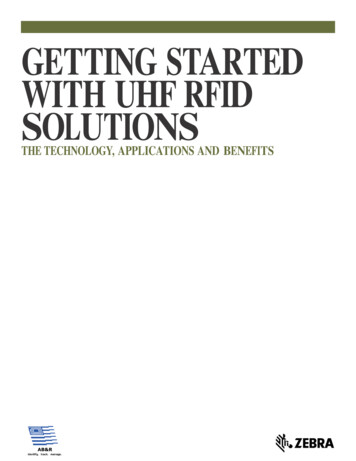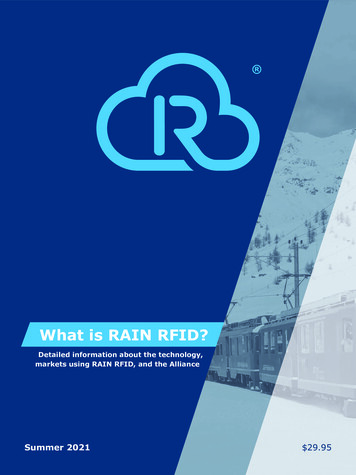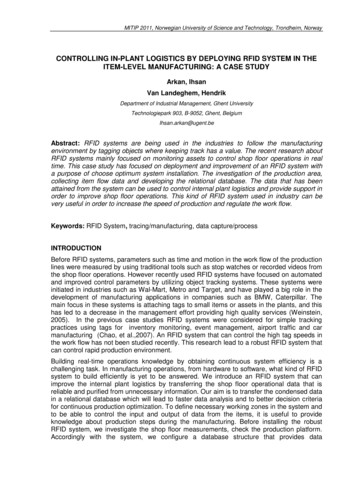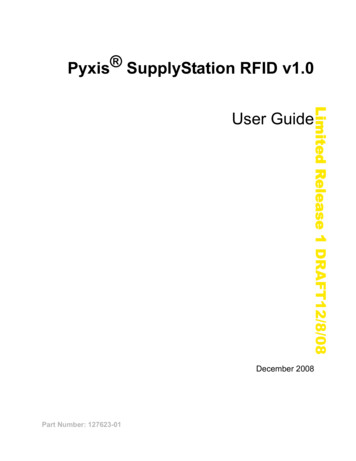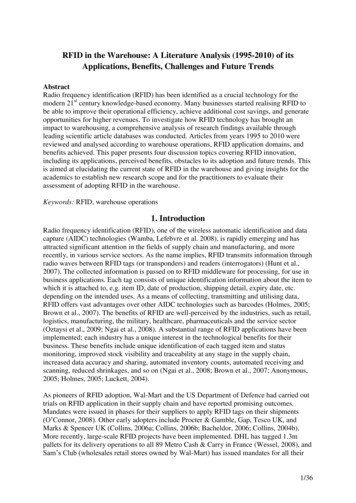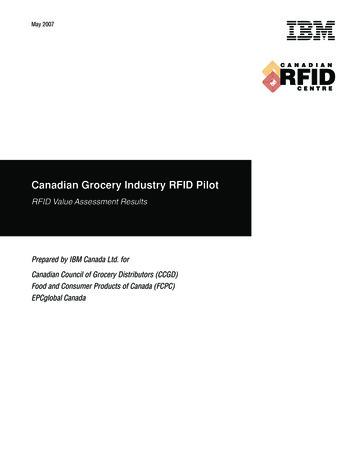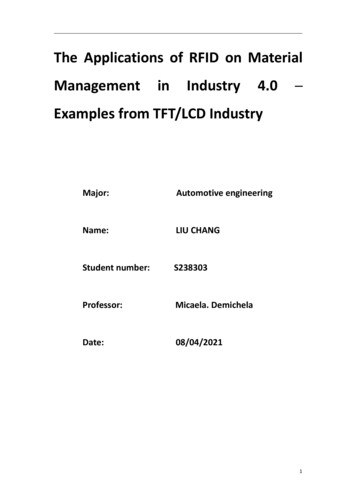
Transcription
The Applications of RFID on MaterialManagementinIndustry4.0 Examples from TFT/LCD IndustryMajor:Automotive engineeringName:LIU CHANGStudent number:S238303Professor:Micaela. DemichelaDate:08/04/20211
CONTENTABSTRACT.5CHAPTER 1 INTRODUCTION.71.1 Research background.71.2 Research motivation.101.3 Research purpose.13Chapter2 ANALYSIS OF THE SECURITY OF RFID in Industry4.0.162.1 RFID radio frequency identification technology.162.1.1Introduction Radio Frequency Identification System.162.1.2The difference between RFID and Barcode.222.2 Security issues based on RFID.242.2.1RFID security threats.242.2.2 RFID risk.252.2.3 Security issues related to RFID communication.252.3 RFID-based attacks.272.3.1 Buffer overflow.272.3.2 SQL injection.282.3.3RFID-based worm.292.3.4 RFID-based virus.292.3.5 Fragmented malicious code based on RFID.302.4 Malicious code immune model based on RFID system.312
2.4.1 Precautions.312.4.2 Security Strategy of Immune Model.322.4.3 Malicious code immunity model .34Chapter 3 RESEARCH CASE INTRODUCTION.363.1 Case company profile.363.2 Description of the company's current inthefuture. 40Chapter 4 RESEARCH METHODS AND ANALYSIS.424.1 Hardware specifications.424.2 RFID system design and process analysis.454.2.1 Material inventory area.484.2.2 Production picking Production picking area. .634.2.4 Feeding storage area.724.2.5 Fixture operation Fixture operation area.804.2.6 Fixture storage area.904.3 Comprehensive benefit analysis.984.3.1 Obvious benefits.1004.3.2 Hidden benefits.1064.4 Application RFID encountered privacy security problem and3
solutions in the system.1074.4.1 Privacy and privacy threats in RFID tectionmethods.117Chapter 5 CONCLUSION.123REFERENCE DOCUMENTS.1254
ABSTRACTThe term “intelligent manufacturing” is not only the developing trend ofindustry but also the critical factor to the fourth industrial revolution.The study here in investigates the synergy of applying RFID gentmaterialmanagement based on TFT-LCD(thin film transistor liquid crystal display)factory’s material management system and on production control withCyber Physical System(CPS) and Internet of Things(IoT) as coretechnology under the structure of industry 4.0.Facing the industry 4.0intelligence tendency, the parallel communication and cooperationamong machines, equipment, people, materials and products is enabledand smart manufacturing monitor of production flow is enhanced withthe assistance of well control over production status collected by theemployment of RFID devices that receive necessary data of the wholeprocess from the input of materials to the end of manufacturing, whileproduction and material management information is operated andrecorded individually, relying on massive manual operations in neithertime-saving nor efficient ways in an industry-3.0-based factory. Moreover,the applications of cloud calculation and big data analysis generatedfrom the real time data of production help to study data-mining strategyfor integration and analysis of process flow. Thus intelligentmanufacturing on production and material management will be more5
productive by the promotion of production application and workshopmanagement flow. The implicit cost of process flow can be lowered,production capability can be enhanced and operators’ function can beupgraded as well.Keywords: Industry 4.0, CPS ( Cyber Physical System ) , RFID (RadioFrequency Identification), Material Management6
CHAPTER 1 INTRODUCTION1.1 Research backgroundLooking back at the development of industry, the first industrialrevolution, mechanization (1729-1830 Industry 1.0) was driven by waterand steam, instead of manpower by machines, evolving from individualcraftsman production methods to factory production models. In thesecond industrial revolution, electric energy from electrification(1870-1920 Industry 2.0) replaced steam power, and the design ofassembly lines in factory production lines improved production efficiency.The industrial revolution of electrification opened an era of massmanufacturing, cost reduction, and process time. The third industrialrevolution, automation (1950-2010 Industry 3.0) machinery, usescomputers and information technology to enhance the development ofindustrial automation. The evolution of automation has also become themost far-reaching industrial revolution so far. The development of thesethree industrial revolutions was due to technological progress, changingthe existing model of industry greatly increased the productivity of theindustry and the new economic development.The fourth industrial revolution, the core main axis of intelligent(2011-Industry 4.0) intelligent manufacturing oriented, combined withintelligence and big data (Big Data), the technical basis is the integration7
of virtual and real (Cyber Physical System, CPS) and the Internet ofThings (Internet of Things) , IoT). From the first industrial revolution tothe fourth industrial revolution, each industrial evolution represents agreat leap forward in the development of new technology andproduction models, which not only improves productivity, but alsochanges the production model of factories. The key to Industry 4.0 is tointegrate the foundations of the previous three industrial revolutions,plus the integration of physical and virtual to achieve smart production.Figure 1-1: Industrial Revolution (Source: Executive Yuan Productivity 4.0Development Plan)The German manufacturing industry has a high level of industrialcapacity in the world. In order to maintain global competitiveness, it isalso aware of the importance of technological change, and solves theglobal problem of population reduction, labor decline, rapid marketchanges, shortened product life cycles, and rising raw material costs.Phenomenon, the high-tech strategic plan "Industry 4.0" proposed byGermany at the Hannover Messe in 2011 is listed as one of the tenfuture plans of the "High-tech Strategy 2020" to consolidate the8
country’s production competitiveness.The "Industry 4.0" proposed by Germany opened the fourth industrialrevolution and the development trend of intelligence, guidinggovernments and industries of various countries to gradually targetsmart manufacturing technology, actively promoting related virtual andreal integration plans, and related policies to revitalize the industry. Thesmart policies of major countries are as dvancedManufacturing Partnership, AMP)2013 UK "Industry 2050 Strategy" (The future of manufacturing: a newera of opportunity and challenge for the UK)2014 South Korea "Industry Innovation 3.0" (Industry Innovation 3.0)2015 Taiwan "Productivity 4.0" (Productivity 4.0)2015 China "Made in China 2025" (Made in China 2025)2015 Japan Industry 4.1J (Japan Industry 4.1J)Smart manufacturing is not only an international trend, but also the keyto the fourth industrial revolution. The development of globalmanufacturing intelligence has become an inevitable trend. It isestimated that the future will promote a new wave of industrialrevolution and accelerate the world industry since the third industrial9
revolution. Modern industry further guides the development of "smartmanufacturing"1.2 Research motivationWhen the world entered the fourth industrial revolution, governments ofvarious countries began to actively support the development ofintelligence in order to maintain their advantages. On the other hand,the pressure of global competition for the development of smarttechnology and the reality of global population reduction acceleratedthe transformation of the manufacturing industry. Pressure was bornspontaneously. Mainland China also released "Made in China 2025" dcommunication network infrastructure required for smart manufacturing,10
transforming from a large manufacturing country to a manufacturingpower from quantity to quality. Facing the trend of industrial intelligencefrom "Industry 4.0", how to enhance competitiveness has become one ofthe most important issues at present[1]."Industry 4.0" is a smart manufacturing-oriented industrial revolution,with virtual and real integration as the core technology, using sensorydevices, and a smart factory based on cloud and big data analysis. Theintroduction of "Industry 4.0" smart manufacturing requires carefulevaluation and capital cost investment. At the beginning of the factory, inthe process of upgrading equipment automation and networkingintegration, a large amount of capital needs to be invested in theconstruction of automation equipment, so when investing Funds and riskconsiderations need to go through a rigorous evaluation plan. How toinvest resources in priority investment that can generate significantbenefits and high added value, and seek more effective key points forentering "Industry 4.0". In this case, the company is a world-classmanufacturer. The product lines produced by the product line are quitediverse in size and the manufacturing process is extremely Complex, thetypes and quantities of materials required for production are huge anddifficult to manage. In terms of material cost, it accounts for about 50%of the total production cost. Its proportion has considerable influence.11
Among them, high-end materials have long delivery times and highcosts. , Every important link in the entire production process is involvedin the purchase, requisition, feeding, and production, and its importanceis even more obvious.In the "Industry 3.0" production process, the raw materials andproduction equipment still remain in a self-operating information entity,and most of the material management stays at the stage of manualoperation or digital record achieved by the inventory system. In the caseof failure, due to the fact that there are many production processparameters and material measurement values that affect each other,engineers can only check machine parameter values site by site, andquery form records to verify the measurement values, which is quitetime-consuming, which leads to slow transmission of informationprocessing messages. , The abnormal reaction can not be dealt withenough to cause the fault of timeliness between operations. Thisresearch explores the intelligent development of "Industry 4.0" materialmanagement in the process of transforming into smart manufacturing.Through the integration of virtual reality and the Internet of Things, fromfeeding production to the end of the process, sensing devices can sensethe status of production operations to assist in production. Operationprocess and monitoring operation process, through intelligent12
management so that information can be mutually effective connection,providing useful integrated data, assisting the efficiency of the entireproduction process and material management, achieving intelligentmanufacturing of production management and material management,not only can significantly improve production efficiency, but also preventhidden costs in the process, and achieve the goal of intelligence.1.3 Research purposeUnder the framework of Industry 4.0, this research uses themanufacturing process materials and production management as thebackground to explore intelligent solutions based on RFID radiofrequency identification systems.RFID radio frequency identification system is a kind of automaticidentification technology. With mature technology and more and moreR&D manufacturers, the cost of installation has dropped significantlycompared with the past, making RFID widely used in many fields, such as:logistics management , Assets and equipment management, productionapplications, medical management, anti-theft applications, industrialsafetymanagement, access control management, card applications, biometrics,item management, etc.13
Using the sensing device to collect a large amount of production-relatedinformation through the Internet of Things. From the start of productionto the end of the production process, the numerical data in the wholeprocess is collected into the cloud database for data analysis, prediction,mining, and various production management systems and automationequipment The information connection is connected in series to form avirtual and real integration framework to achieve the connectionbetween equipment and equipment, the operation of people andequipment, and the connection between materials and equipment,realize the sharing and integration of production, equipment, people,and materials, and assist the production process to make auxiliaryproduction decisions and manual errors[2].This study is based on the case company's process materials as a samplefor this study, and discusses current operating issues based on theIndustry 4.0 framework:(1)Traditional data analysis capabilities are no longer sufficient to reflectthe true cause of the problem(2)A small number of products, a variety of products, variable schedules,short product life cycles, and insufficient response mastery(3)Long material delivery time, high price, insufficient logisticsinformation14
(4)High process standards, complex product specifications, and highdynamic adjustability(5)The traditional single-site form statistics method cannot concatenateinformation(6)There is no information link between production information andproduction materials and equipment, and there is insufficient mastery ofmaterial informationAiming at the end of the life cycle of process materials from feed toproduction, the intelligent operation process research under theframework of Industry 4.0, through this research, hopes to achieve thefollowing goals:(1)How does industry 4.0 intelligence improve manufacturing efficiencyand competitiveness(2)Link production management and process materials to achieve factoryefficiency(3)Material management achieves smart logistics efficiency(4)Maximize per capita output value(5)Production management and yield control and prevention15
Chapter2 ANALYSIS OF THE SECURITY OFRFID in Industry 4.02.1RFID radio frequency identification technology2.1.1Introduction Radio Frequency Identification System:Reading the relevant data by means of radio waves to achieve thetransmission of information[3].RFID has been used in many fields such as: logistics management(material operations, warehousing, inventory, etc.), asset equipmentmanagement (fixed assets, items, fixtures, etc.), production applications(equipment control, automation control, etc.), medical management(electronic medical records, Special item management, etc.), anti-theftapplications (car anti-theft, store anti-theft, etc.), MRTsystems,etc.),anti-counterfeiting management (valuable certificates, confidentialdocuments, etc.), industrial safety management (special work spaces,etc.) ), access control management (access control monitoring, personnelmanagement, etc.), card application (Smart card, leisure card, ID card,etc.), biometrics (pet identification, wild animal ecological tracking), itemmanagement (luggage identification, logistics transportation, etc.) arewidely used.16
The radio frequency identification system originated from thedevelopment of the British (1948) during the Second World War[14] .The IFF (Identify Friend of Foe) system was used to identify the use ofenemy or enemy fighters, and related papers after 1950. It waspublished; in 1973, Mario Cardullo obtained the first American activeRFID tag (Radio Frequency Identification Tag, RFID Tag) patent; CharlesWalton obtained another patent for passive RFID tags. After 1975, RFIDtechnology began to be commercialized and popularized.And then it iswidely cited and developed for different purposes by countries all overthe world.The radio frequency identification system is regarded as one of the tenmost important technologies of the century. In 2005, Wal-Mart, theleader of the global department store retail industry, began to apply RFIDtags to speed up the efficiency of the supply process. This has led to theapplication trend of RFID among industries [4]. Technavio (InfinitiResearch Ltd.) research shows that the global industrial RFID market willcontinue to grow rapidly at a compound annual growth rate of 19.2%from 2016 to 2020[17] . The barcode system is not only time-consuming,but also the risk of high error rate due to manual data input, while RFIDcan automatically identify data and record more accurately. With thecontinuous development of industrial technology, industrial RFID is17
developing rapidly [17]. The global RFID market is predicted to reach ascale of 13.2 billion U.S. dollars by 2020[18].The RFID system is mainly composed of a reader (RFID Reader) Figure 2-7,RFID radio frequency tag (RFID Tag) Figure 2-8, Antenna (Antenna) andapplication system (Application) Figure 2-6, using RFID to read Thedevice emits radio waves, drives the RFID radio frequency tag within thesensing range through the antenna, and transmits the data of the RFIDradio frequency tag to the reader through the principle ofelectromagnetic space coupling of radio waves to realize non-contactinformation transmission applications[5]. Then through the back-endapplication system for information interpretation and use, to achieve thepurpose of identification[13].figure 2-6: Schematic diagram of RFID operation18
Figure 2-7: RFID Reader (Data source: micro program informationhttps://www.program.com.tw, 2017)RFID tag (RFID Tag) is the data carrier of RFID radio frequencyidentification system[15]. Figure 2-8 is composed of chip (Substrate) andantenna coil (Antenna Coil). Each tag has a unique electronic code. ,Stores the electronic mark information for identification, and can bedivided into read-only and readable and writable according to itscapabilities.The RFID radio frequency tag is attached to the identification object toidentify the target object. When the RFID reader emits radio waves togenerate electromagnetic principles, the RFID radio frequency tag willreturn a unique electronic code after re ceiving the reader signal for theRFID reader to process and identify[6].Figure 2-8: RFID Radio Frequency Tag (RFID TAG) (Source: TI.com,19
compiled by Digitimes, 2014) [16]RFID radio frequency tags can be divided into active (Passive Tag) andpassive (Active Tag) two types:Active RFID tag (Figure 2-9): It contains a battery, and the energy drivenby its own battery actively returns data to the RFID reader.Advantages: long transmission distance and large memory capacity.Disadvantages: high cost, limited battery lifeFigure 2-9: Active RFID Radio Frequency Tag (RFID TAG) (Source:Microprogram Information https://www.program.com.tw, 2017)Passive RFID tags (Figure 2-10): The principle of electromagneticgeneration by radio waves emitted by an RFID readerAdvantages: small size, low cost, long life.Disadvantages: short distance, one-way information transmission.20
Figure 2-10: Passive RFID radio frequency tag (RFID TAG) (Source:Metalcraft, Inc., 2017) [20]Table 2-2: Comparison of RFID active and passive tagsActive and passive labelcomparisonPower sourcecost priceReading distanceService lifeMemory capacitySizeActivepassiveBattery poweredhigherFar (video rate)Limited batteryLarge: Read and writeLarge: Depends on batterysizeElectromagnetic drivelowerNear (video rate)No battery, unlimitedSmall: Read OnlySmall: like a stickerIn addition to the difference between active and passive RFID radiofrequency tags, the following common RFID system frequencies can bedistinguished according to the different frequency bands betweenelectronic tags and RFID readers: Low Frequency (LF), High Frequency(HF), Ultra High frequency (Ultra High Frequency, UHF) and microwave(Microwave, MW).frequencyRead rangeLow frequencyLF120 150KHzhigh frequencyHF13.56 KHzSystem TypepassivepassiveUHFUHF866 928KHz;433KHzpassiveActivemicrowaveMW2.45 5.8 GHz;3.1-10 GHzActiveActive andpassive21
Read rangeData speedScope ofapplication cess control 1mmediumSmart ticketcardAccess control 12m 100mMid to highmediumMaterial managementasset ManagementDefense applications 2mhigh 200mhighhighwayElectronic TollTable 2-3: RFID system frequency specifications and characteristics[15;16]2.1.2The difference between RFID and BarcodeWith the widespread use of RFID and the maturity of the automationenvironment, radio frequency identification systems have graduallyreceived industry attention and applications. RFID has the advantages ofnon-contact sensing and reading and writing. It can read a large amountof radio frequency tag information at one time, and maintains goodobject penetration in non-metal and liquid environments.Within the scope of the radio frequency identification system, radiofrequency tags can actively return information to the RFID reader.Compared with traditional barcode tags (Barcode) Figure 2-11, the use ofphotoelectric effect can only read one dimension at a time The bar codelabel method, the radio frequency identification system has a highdegree of automation, in addition to saving a lot of manual time, butalso reducing the incidence of human error.22
Figure 2-11: Barcode label (Barcode)In summary, RFID technology has better performance than traditionaltags in terms of sensing method, reading and writing ability, distance,usability, penetration, and service life.The differences between RFID and Barcode are explained as follows:Table 2-4[19]Number of readsRead directionalityLabor costsLiteracyService lifesafetyRFIDHigh: can automaticallyread multiple tags at thesame time ( 100)No need: as long as the tagis within the reading range,no specific directionality ordirect line of sight isrequiredAlmost none: oncerunning, the system is fullyautomatedMore than just reading.With the ability to read,write, modify and updatehigh. High durability, andcan be read in very harshenvironmentshigh. It is difficult to copydata and can be encryptedand protected, so thestored information is moresecure.BarcodeLow: The label can only beread manually, and onlyone can be read at a time.Absolutely necessary: thescanner needs to scandirectly in a very specificwayManpower hours: Theoperator must scan eachlabel.Can only readlow. Easy to damage orbreak; dirty or greasy canalso make it impossible toscanlow. Easy to be copied orforged23
2.2 Security issues based on RFIDThe following is the definition of data security in RFID[8](1)Access to data is restricted: information that is read and written to thedatabase needs to be authenticated.(2)The access system is restricted: all devices of the access system mustbe authenticated and trusted.(3)The system is safe and trustworthy: the most basic point is that thesystem must be safe and reliable.RFID technology has shortcomings in terms of security and privacy. Thesecurity of RFID systems mostly depends on the development ofmiddleware and the data contained in RFID tags. These data may causeSOL injection attacks, denial of service attacks, and buffer overflows[7].2.2.1RFID security threats(1) Sniffing. Any corresponding reading device can read the taginformation, and the reading behavior does not need to be aware of thetag load, and it can happen at a long distance.(2) Tracking. The reader can record a unique visual tag identifier at aspecific location, and then associate it with personal identity.(3) Respond to the attack. Attackers use answering equipment tointercept and forward RFID queries[6].(4) Denial of service. Denial of Service (DoS) prevents the RFID system24
from working normally, such as signaling congestion will prevent thecommunication between the radio frequency wave and the tag.2.2.2 RFID risk(1) Data read error. Network errors, virus infection of middleware, orsignal interruption during data transmission can occur, which can lead toinaccurate statistics.(2) The disclosure of business information. The attacker illegallyaccessed the RFID system to obtain commercially sensitive information.(3) Personal privacy is exposed. Obtained by tracking the label residingin the product Customer's residential address and some personalinformation.(4) External risks. When the RFID system is connected to externalnetworks, these networks the attack will indirectly or directly threatenthe FRID system.2.2.3 Security issues related to RFID communicationTag readers have two communication methods: transmitting data viaInternet Protocol (IP) and providing and collecting data sent or arriving atthe tag via low-power radio (radio frequency, RF ). Both methods havesome security issues.(1) Data transmission via IPUnauthorized access to the network is an important security threat, andany malicious device should be prevented from accessing the network.25
The use of technologies such as SSL and SSH can ensure network security.These technologies close some ports that can be maliciously used byattackers to ensure that the system is more secure. More security toolsand higher technical standards make this communication methodrelatively safe.(2) Provide and collect data through low-power RFThis method is carried out in the air and will cause some seriousthreats:Unauthorized tag access (resulting in sniffing). In theory, all tagsshould be authenticated by an RFID reader before being read. However,a loophole in the tag allows a fake reader to read the completeinformation in the tag, write arbitrary malicious data into the tag, andeven terminate or destroy the tag. Since the tag can be read anywherewithin the range of the RFID reader, it can be used to steal a digitalpassport[6].Cloning tags (resulting in deception). A cloned tag is an unauthorizedcopy of the original tag, and the reader will read it as the original tag, sothe reader can be accessed illegally. Cloning tags will inject erroneous ormalicious data into the system, destroying the integrity of the systemand the data in the system[9].26
Channel attacks (resulting in replay attacks). At present, the biggestsecurity threat is that malicious devices eavesdrop on theircommunications between tags and readers, and wait for opportunities tosteal passwords and other sensitive information, which will also lead toman-in-the-middle attacks.2.3 RFID-based attacks2.3.1 Buffer overflowBuffer overflow is the most common type of software attack. Bufferoverflow means that when the computer fills the buffer with the numberof bits of data that exceeds the capacity of the buffer itself, theoverflowed data is overwritten on the legal data.Buffer overflow meansthat the intruder directly (such as user input) or indirectly (throughenvironmental variables) input data, the input data is greater than thelength of the buffer allocated to the memory, so that it overflows andoverwrites the legal data. The location of the program control data in thememory is usually adjacent to the data buffer, and the buffer overflowmakes the program execute the code at will. RF ID tag buffer overflowwill endanger the security of the middleware back-end system. The tagdata is generally less than 1024bit, but the "write mu-hiple blocks"command in 150--15693 allows tags to repeatedly send the same datamodule, which will eventually fill the application layer cache.27
2.3.2 SQL injectionSQL injection is caused by security vulnerabilities in the database layer ofthe application. It is an attack technique that uses the Web site to alterthe background SQL statement by forging the requester's input. In RFIDsystems, this kind of vulnerabilities are common in middleware. Thereare several methods for SQ L inje
Figure 2-7: RFID Reader (Data source: micro program information https://www.program.com.tw,2017) RFID tag (RFID Tag) is the data carrier of RFID radio frequency (Substrate)and antenna coil (Antenna Coil). Each tag has a unique electronic code. ,



